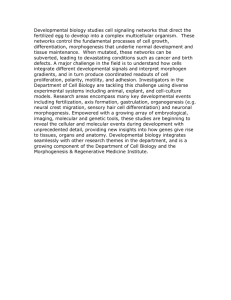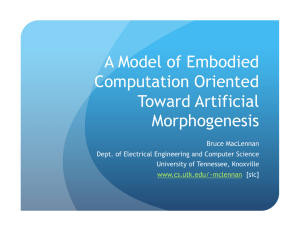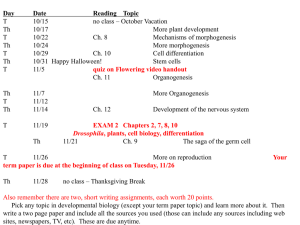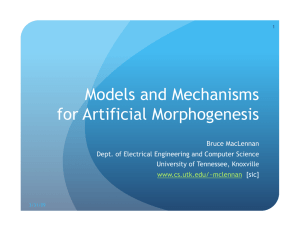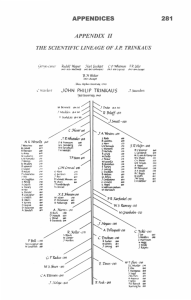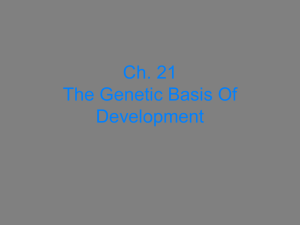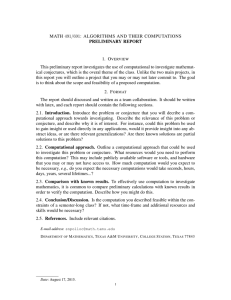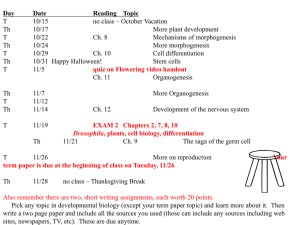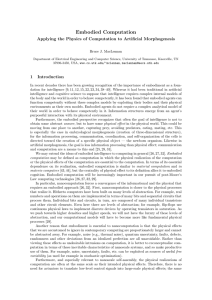Configuration and Reconfiguration of Complex Systems by Artificial Morphogenesis
advertisement
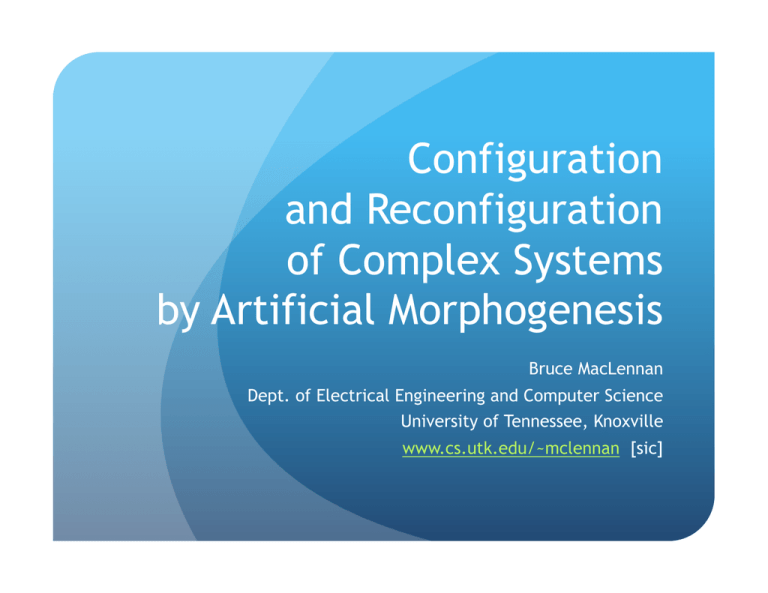
Configuration and Reconfiguration of Complex Systems by Artificial Morphogenesis Bruce MacLennan Dept. of Electrical Engineering and Computer Science University of Tennessee, Knoxville www.cs.utk.edu/~mclennan [sic] 2 Long-Range Challenge How can we (re)configure systems that have complex hierarchical structures from microscale to macroscale? Examples: reconfigurable robots other computational systems with reconfigurable sensors, actuators, and computational resources brain-scale neurocomputers noncomputational systems and devices that would be infeasible to fabricate or manufacture in other ways systems organized from nanoscale up to macroscale 7/22/09 Motivation for Artificial Morphogenesis Embryological morphogenesis shows how to organize millions of relatively simple units to self-assemble into complex, hierarchical structures Morphogenesis: creation of 3D pattern & form in matter Characteristics: structure implements function function creates structure no fixed coordinate frame soft matter sequential (overlapping) phases temporal structure creates spatial structure 7/22/09 3 Artificial Morphogenesis 4 Morphogenesis can coordinate: proliferation movement disassembly to produce complex, hierarchical systems Approach: use AM for multiphase selforganization of complex, functional, active hierarchical systems 7/22/09 (Images from internet) Self-Organization of Physical Pattern and 3D Form 7/22/09 (Images from Wikipedia) 5 6 Reconfiguration & Metamorphosis Degrees of metamorphosis: incomplete complete Phase 1: partial or complete dissolution Phase 2: morphogenetic reconfiguration (Images from Wikipedia) 7/22/09 Microrobots, Cells, and Macromolecules 7/22/09 7 8 Components Both active and passive Simple, local sensors (chemical, etc.) Simple effectors local action (motion, shape, adhesion) signal production (chemical, etc.) Simple regulatory circuits (need not be electrical) Self-reproducing or not Ambient energy and/or fuel 7/22/09 9 Metaphors for Morphogenesis Donna Haraway: Crystals, Fabrics, and Fields: Metaphors that Shape Embryos (1976) — a history of embryology The fourth metaphor is soft matter: 1. crystals 2. fabrics 3. fields 4. soft matter 7/22/09 Fundamental Processes* directed mitosis differential growth apoptosis differential adhesion condensation contraction matrix modification migration diffusion chemokinesis chemotaxis haptotaxis cell-autonomous modification of cell state asymmetric mitosis temporal dynamics inductive modif. of state hierarchic emergent 7/22/09 * Salazar-Ciudad, Jernvall, & Newman (2003) 10 11 Embodied Computing Embodiment: “the interplay of information and physical processes.” — Pfeifer, Lungarella, & Iida (2007) Cf. embodied cognition, embodied AI Embodied computation = computation whose physical realization is directly involved in computational process or its goals Includes computational processes: that directly exploit physical processes for computational ends in which information representations and processes are implicit in physics of system and environment in which intended effects of computation include growth, assembly, development, transformation, reconfiguration, or disassembly of the physical system embodying the computation 7/22/09 Motivation for Embodied Computing Post-Moore’s Law computing Computation for free Noise, defects, errors, indeterminacy Massive parallelism Self-making (the computation creates the computational medium) Adaptation and reconfiguration E.g. diffusion Self-repair E.g., cell sorting by differential adhesion Self-destruction Exploration vs. exploitation 7/22/09 Representation for free 12 13 Disadvantages Less idealized Energy issues Lack of commonly accepted and widely applicable models of computation But nature provides good examples of how: computation can exploit physics without opposing it information processing systems can interact fruitfully with physical embodiment of selves & other systems 7/22/09 14 A preliminary model for morphogenesis as an approach to the configuration and reconfiguration of physical systems 7/22/09 15 Some Prior Work Plant morphogenesis (Prusinkiewicz, 1988–) Evolvable Development Model (Dellaert & Beer, 1994) Fleischer Model (1995–6) CompuCell3D (Cickovski, Izaguirre, et al., 2003–) CPL (Cell Programming Language, Agarwal, 1995) Morphogenesis as Amorphous Computation (Bhattacharyya, 2006) Many specific morphogenetic models Field Computation (MacLennan, 1987–) 7/22/09 16 Goals & Requirements Continuous processes Complementarity Intensive quantities Coordinate-independent behavioral description Mathematical interpretation Embodied computation in solids, liquids, gases — especially soft matter Operational interpretation Active and passive elements Multiple space & time scales Energetic issues Stochastic 7/22/09 Influence models 17 Substances Complemenarity physical continua phenomenological continua Substance = class of continua with similar properties Examples: solid, liquid, gas, incompressible, viscous, elastic, viscoelastic, physical fields, … Multiple realizations as physical substances Organized into a class hierarchy Similarities and differences to class hierarchies in OOP 7/22/09 18 Bodies (Tissues) Composed of substances Deform according to their dynamical laws May be able to interpenetrate and interact with other bodies 7/22/09 19 Mathematical Definition A body is a set B of particles P At time t, p = Ct (P) is position of particle P Ct defines the configuration of B at time t Reflects the deformation of the body C is a diffeomorphism 7/22/09 P Embodied Computation System for Morphogenesis An embodied computation system for morphogenesis comprises a finite number of bodies of specified substances Each body is prepared in an initial state specify region initially occupied by body specify initial values of variables should be physically feasible System proceeds to compute, according to its dynamical laws in interaction with its environment 7/22/09 20 21 Elements (Particles or material points) 7/22/09 22 Material vs. Spatial Description Material (Lagrangian) vs. spatial (Eulerian) reference frame Physical property Q considered a function Q (P, t) of fixed particle P as it moves through space rather than a function q (p, t) of fixed location p through which particles move Reference frames are related by configuration function p = Ct (P) Example: velocity 7/22/09 23 Intensive vs. Extensive Quantities Want independence from size of elements Use intensive quantities so far as possible Examples: mass density vs. mass number density vs. particle number Continuum mechanics vs. statistical mechanics Issue: small sample effects 7/22/09 24 Behavior 7/22/09 25 Particle-Oriented Description Often convenient to think of behavior from particle’s perspective Coordinate-independent quantities: vectors and higherorder tensors Mass quantities as random variables 7/22/09 26 Material Derivatives For particle-oriented description: take time derivatives with respect to fixed particle as opposed to fixed location in space Conversion: All derivatives are assumed to be relative to their body 7/22/09 27 Change Equations Want to maintain complementarity between discrete and continuous descriptions: Neutral “change equation”: 7/22/09 28 Qualitative “Regulations” Influence models indicate how one quantity enhances or represses increase of another Y We write as “regulations”: Meaning: where F is monotonically non-decreasing Relative magnitudes: 7/22/09 Z X 29 Stochastic Change Equations Indeterminacy is unavoidable Wt is Wiener process Complementarity dictates Itō interpretation 7/22/09 Interpretation of Wiener Derivative Wiener process is nowhere differentiable May be interpreted as random variable Multidimensional Wiener processes considered as primitives 7/22/09 30 31 Examples 7/22/09 32 Simple Diffusion 7/22/09 A Simple Diffusion System 7/22/09 33 Activator-Inhibitor System 7/22/09 34 Activator-Inhibitor System as Regulations 7/22/09 35 Vasculogenesis* (Morphogen) 7/22/09 * from Ambrosi, Bussolino, Gamba, Serini & al. 36 37 Vasculogenesis (Cell Mass) 7/22/09 Vasculogenesis (Cell-Mass Behavior) 7/22/09 38 Clock-and-Wavefront Model of Segmentation Vertebrae: humans have 33, chickens 35, mice 65, corn snake 315 — characteristic of species How does developing embryo count them? Somites also govern development of organs Clock-and-wavefront model of Cooke & Zeeman (1976), recently confirmed (2008) Depends on clock, excitable medium (cell-to-cell signaling), and diffusion 7/22/09 39 Simulated Segmentation by Clock-and-Wavefront Process 7/22/09 40 2D Simulation of Clock-and-Wavefront Process 7/22/09 41 42 500 1000 2000 4000 5000 7/22/09 Effect of Growth Rate 43 Example of Path Routing Agent seeks attractant at destination Agent avoids repellant from existing paths Quiescent interval (for attractant decay) Each path occupies ~0.1% of space Total: ~4% 7/22/09 44 Example of Connection Formation 10 random “axons” (red) and “dendrites” (blue) Each repels own kind Simulation stopped after 100 connections (yellow) formed 7/22/09 Conclusions & Future Work Artificial morphogenesis is a promising approach to configuration and reconfiguration of complex hierarchical systems Biologists are discovering many morphogenetic processes, which we can apply in a variety of media We need new formal tools for expressing and analyzing morphogenesis and other embodied computational processes Our work is focused on the development of these tools and their application to artificial morphogenesis 7/22/09 45 46 Extra Slides 7/22/09 47 Example of Path Routing Starts and ends chosen randomly Quiescent interval (for attractant decay) omitted from video Each path occupies ~0.1% of space Total: ~4% 7/22/09 48 Example of Connection Formation 10 random “axons” (red) and “dendrites” (blue) Simulation stopped after 100 connections (yellow) formed 7/22/09
